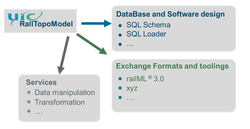RTM quick start
|
|
UIC RailTopoModel, is a universal railway business model, which aims to define railway objects and events in a standard form (UML), to show how they interact with each other, and how they are expected to be used. As such, it aims to standardise the process for designing any business process, data structure, IT software and data flow in the railway industry.
The RailTopoModel is described in UML notation.
One of the first deliverables based on UIC RailTopoModel will be an enhanced version of the standard exchange format railML, with the announcement of railML3.0. Other deliverables will come, as SQL Format and loader, etc.
Motivation
One of the greatest challenges for today’s railway sector is to establish a format and mechanism to transfer data both internally across an organisation and externally between organisations. This has arisen from the lack of a standardised data exchange format and a single industry wide approach.
To date there has been little coordination or consensus within the railway community over a standard for the exchange of data. Thus multiple standards have been developed for specific purposes, each with its own data definition (model) and file format (2).
The consequences of this have been:
- Laboured and repetitive developments in IT,
- Long project lead times, and
- Incompatibility between different standards, which has prevented the development of transformation software in a competitive market.
As such, each data model and format cannot be used for other purposes. Examples include formats designed for RINF, INSPIRE, ETCS projects, etc.
